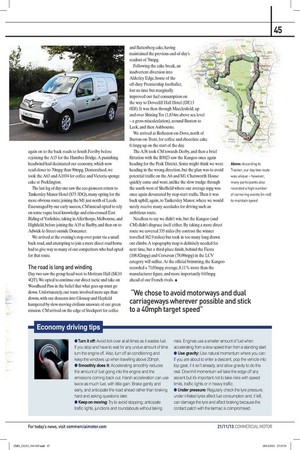Econom dri ing lips
Page 35

If you've noticed an error in this article please click here to report it so we can fix it.
• Turn it off: Avoid tick-over at all times as it wastes fuel. If you stop and have to wait for any undue amount of time turn the engine off. Also, turn off air-conditioning and keep the windows up when travelling above 20mph.
• Smoothly does it: Accelerating smoothly reduces the amount of fuel going into the engine and the emissions coming back out. Harsh acceleration can use twice as much fuel, with little gain. Brake gently and early, and anticipate the road ahead rather than braking hard and asking questions later. • Keep on moving: Try to avoid stopping; anticipate traffic lights, junctions and roundabouts without taking
risks. Engines use a smaller amount of fuel when accelerating from a slow speed than from a standing start.
• Use gravity: Use natural momentum where you can. If you are about to enter a descent, pop the vehicle into top gear, if it isn't already, and allow gravity to do the rest. Downhill momentum will take the edge off any ascent but it's important not to take risks with speed limits, traffic lights or in heavy traffic.
• Under pressure: Regularly check the tyre pressure; under inflated tyres affect fuel consumption and, if left, can damage the tyre and affect braking because the contact patch with the tarmac is compromised.






































